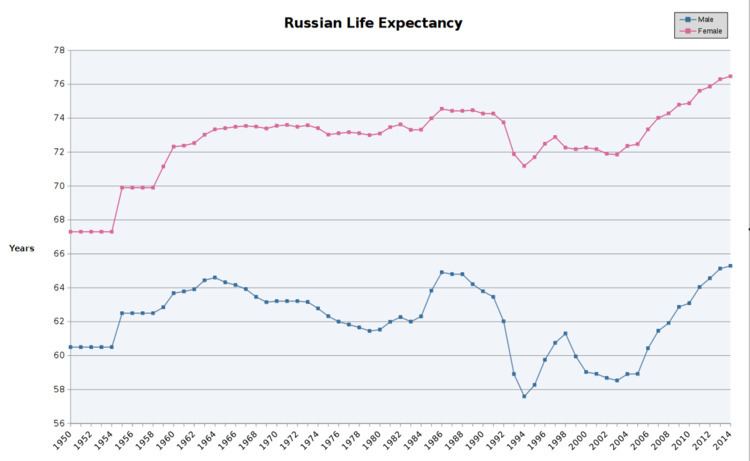 | ||
Health in Russia deteriorated rapidly following the collapse of the Soviet Union, particularly for men, as a result of social, economic, and lifestyle changes. It has now improved considerably.
Contents
Life expectancy
As of 2013, the average life expectancy in Russia was 65.1 years for males and 76.5 years for females. The average Russian life expectancy of 71.6 years at birth is nearly 5 years shorter than the overall average figure for the European Union, or the United States.
The biggest factor contributing to this relatively low life expectancy for males is a high mortality rate among working-age males from preventable causes (e.g., alcohol poisoning, stress, smoking, traffic accidents, violent crimes). Mortality among Russian men rose by 60% since 1991, four to five times higher than European average.
As a result of the large difference in life expectancy between men and women, (the greatest in the world) the gender imbalance remains to this day and there are 0.859 males to every female.
Common causes of death
In 2008, 1,185,993, or 57% of all deaths in Russia were caused by cardiovascular disease. The second leading cause of death was cancer which claimed 289,257 lives (14%). External causes of death such as suicide (1.8%), road accidents (1.7%), murders (1.1%), accidental alcohol poisoning (1.1%), and accidental drowning (0.5%), claimed 244,463 lives in total (11%). Other major causes of death were diseases of the digestive system (4.3%), respiratory disease (3.8%), infectious and parasitic diseases (1.6%), and tuberculosis (1.2%).
The infant mortality rate in 2008 was 8.5 deaths per 1,000, down from 9.6 in 2007. Since the Soviet collapse, there has been a dramatic rise in both cases of and deaths from tuberculosis, with the disease being particularly widespread amongst prison inmates.
Smoking
Until 2007 Russia was the world leader in smoking. According to a survey reported in 2010 by Russia’s Health and Social Development Ministry, 43.9 million adults in Russia are smokers. Among Russians aged 19 to 44 years, 7 in 10 men smoke and 4 in 10 women smoke. It is estimated that 330,000-400,000 people die in Russia each year due to smoking-related diseases. A smoking ban was introduced in 2014.
Alcohol consumption
Alcohol consumption and alcoholism are major problems in Russia. It is estimated that Russians drink 15 litres (26 pints) of pure alcohol each year. This number is nearly 3 times as much as it was in 1990. In Moscow on September 24 of 2009, Russia's interior minister Rashid Nurgaliyev cited the average intake at an estimated 18 liters a year; "In Russia, each person, including babies, accounts for about 18 liters of spirits per year. In the opinion of WHO experts, consumption of more than 8 liters per year poses a real threat to the health of the nation. Russia has long exceeded this level". It has even been reported that excessive alcohol consumption is to blame for nearly half of all premature deaths in Russia.
A recent study blamed alcohol for more than half the deaths (52%) among Russians aged 15 to 54 from 1990 to 2001. For the same demographic, this compares to 4% of deaths for the rest of the world.
HIV/AIDS
HIV/AIDS, virtually non-existent in the Soviet era, rapidly spread following the collapse, mainly through the explosive growth of intravenous drug use. According to a 2008 report by UNAIDS, the HIV epidemic in Russia continues to grow, but at a slower pace than in the late 1990s. At the end of December 2007 the number of registered HIV cases in Russia was 416,113, with 42,770 new registered cases that year. The actual number of people living with HIV in Russia is estimated to be about 940,000. In 2007, 83% of HIV infections in Russia were registered among injecting drug users, 6% among sex workers, and 5% among prisoners. However, there is clear evidence of a significant rise in heterosexual transmission. In 2007, 93.19% of adults and children with advanced HIV infection were receiving antiretroviral therapy.
In April 2006, the State Council met with the Russian President to set goals for developing a strategy for responding to AIDS; improving coordination, through the creation of a high-level multisectoral governmental commission on AIDS; and establishing a unified monitoring and evaluation system. A new Federal AIDS Program for 2007 - 2011 was also developed and adopted. Federal funding for the national AIDS response in 2006 had increased more than twentyfold compared to 2005, and the 2007 budget doubled that of 2006, adding to the already substantial funds provided by the main donor organizations.
Coordination of activities in responding to AIDS remains a challenge for Russia, despite increased efforts. In 2006, treatment for some patients was interrupted due to delays in tender procedures and unexpected difficulties with customs. Additionally, lack of full commitment to an in-depth program for education on sex and drugs in schools hinders effective prevention programs for children.
Suicide
In 2008, suicide claimed 38,406 lives in Russia. With a rate of 27.1 suicides per 100,000 people, Russia has one of the highest suicide rates in the world, although it has been steadily decreasing since it peaked at around 40 per 100,000 in the mid-late 90s, including a 30% drop from 2001 to 2006. In 2007 about 22% of all suicides were committed by people aged 40–49, and almost six times as many Russian males commit suicide than females.
Heavy alcohol use is a significant factor in the suicide rate, with an estimated half of all suicides a result of alcohol abuse. This is evidenced by the fact that Russia's suicide rate since the mid-90s has declined alongside per capita alcohol consumption, despite the economic crises since then; alcohol consumption is more of a factor than economic conditions.
